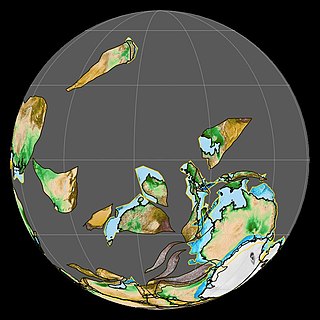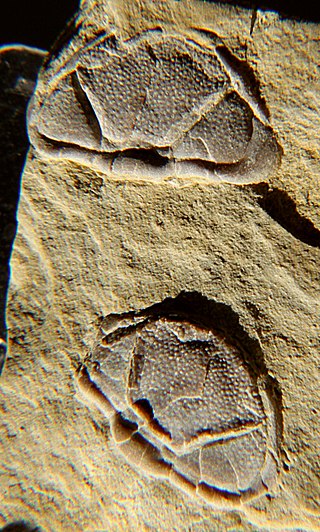| Coumiac Formation | |
|---|---|
| Stratigraphic range: Devonian | |
| Type | Formation |
| Location | |
| Country | France |
The Coumiac Formation is a geologic formation in France. It preserves fossils dated to the Devonian period.
The Global Boundary Stratotype Section and Point (GSSP) for the base of the Famennian Stage of the Devonian is located at Coumiac quarry ( 43°28′14″N3°03′35″E / 43.4705°N 3.0597°E ) near Cessenon-sur-Orb. [1]

The Late Devonian extinction consisted of several extinction events in the Late Devonian Epoch, which collectively represent one of the five largest mass extinction events in the history of life on Earth. The term primarily refers to a major extinction, the Kellwasser event, also known as the Frasnian-Famennian extinction, which occurred around 372 million years ago, at the boundary between the Frasnian age and the Famennian age, the last age in the Devonian Period. Overall, 19% of all families and 50% of all genera became extinct. A second mass extinction called the Hangenberg event, also known as the end-Devonian extinction, occurred 359 million years ago, bringing an end to the Famennian and Devonian, as the world transitioned into the Carboniferous Period.

The Frasnian is one of two faunal stages in the Late Devonian Period. It lasted from 382.7 million years ago to 372.2 million years ago. It was preceded by the Givetian Stage and followed by the Famennian Stage.
The Famennian is the later of two faunal stages in the Late Devonian epoch. The most recent estimate for its duration is that it lasted from around 371.1 to 359.3 million years ago. An earlier 2012 estimate, still used by the International Commission on Stratigraphy, is that it lasted from 372.2 million years ago to 358.9 million years ago. It was preceded by the Frasnian stage and followed by the Tournaisian stage.

The Tournaisian is in the ICS geologic timescale the lowest stage or oldest age of the Mississippian, the oldest subsystem of the Carboniferous. The Tournaisian age lasted from 358.9 Ma to 346.7 Ma. It is preceded by the Famennian and is followed by the Viséan. In global stratigraphy, the Tournaisian contains two substages: the Hastarian and Ivorian. These two substages were originally designated as European regional stages.

Trimerocephalus is a genus of eyeless trilobites from the order Phacopida, family Phacopidae. It lived during the final stage of the Devonian, the Famennian, and became extinct at the end of this stage, together with all other trilobites with the exception of some Proetida. It can be found in Australia, the Czech Republic, France, Germany, Iran, Kazakhstan, Morocco, Poland, the Russian Federation (Urals), Spain, and the United Kingdom (England).
Aulatornoceratinae is one of three subfamilies of the goniatitid family Tornoceratidae, an extinct order of Paleozoic ammonoid cephalopods. Aulotornoceratinae was established as a subfamily by R.T.Becker, 1993, initially for Aulatornoceras, named by Schindewolf, 1922. Subsequently, four other genera have been added.

Holdenius is an extinct genus of arthrodire placoderm fish which lived during the Late Devonian period.
Falcitornoceras is a goniatitid ammonite from the Late Devonian, early Famennian, that has been found in France and Spain. Falcitornoceras was named by House and Price, 1985, and is the type genus for the subfamily Falcitornoceratinae.
The Java Formation is a geologic formation in Kentucky, New York, Ohio, Pennsylvania, Tennessee, Virginia, West Virginia. It preserves fossils dating back to the Devonian period. The formation comprises the Pipe Creek Shale, Wiscoy Sandstone Member in New York, and Hanover Shale Member except in Tennessee.
The Alexo Formation a stratigraphic unit of Late Devonian age. It is present on the western edge of the Western Canada Sedimentary Basin in the central Rocky Mountains and foothills of Alberta. The formation consists primarily of dolomite. It is locally fossiliferous and includes remains of marine animals such as brachiopods and conodonts.
The Simla Formation is a stratigraphic unit of Late Devonian age. It is present on the western edge of the Western Canada Sedimentary Basin in the Rocky Mountains and foothills of west-central Alberta and east-central British Columbia. It consists primarily of carbonate rocks and siltstone, and was named for Mount Simla in northern Jasper National Park by D. J. McLaren and E. W. Mountjoy in 1962.
The Blacourt Formation is a geologic formation in France. It preserves fossils dating back to the Devonian period.
The Harrylock Formation is a geologic formation in Ireland. It preserves fossils dating back to the Devonian period.
Palmatolepis is an extinct conodont genus in the family Palmatolepidae. It was the most abundant genus of conodonts of the Late Devonian, disappearing during the Devonian/Carboniferous crisis.
Icriodus is an extinct conodont genus in the family Gnathodontidae.
Ancyrodella is an extinct genus of conodonts from the Late Devonian.
Ancyrognathus is an extinct genus of conodonts.
Cryptotaxis is an extinct genus of conodonts in the family Cryptotaxidae from the Famennian.
Craniops is an extinct genus of brachiopods in the family Craniopsidae with species known from the Ordovocian to the Devonian.
Dudleyaspis is an extinct genus of Lower to Middle Devonian odontopleurid trilobites that lived in a shallow sea that lay between Euramerica and Gondwana. It was named in 1949 by Prantl & Pribyl.